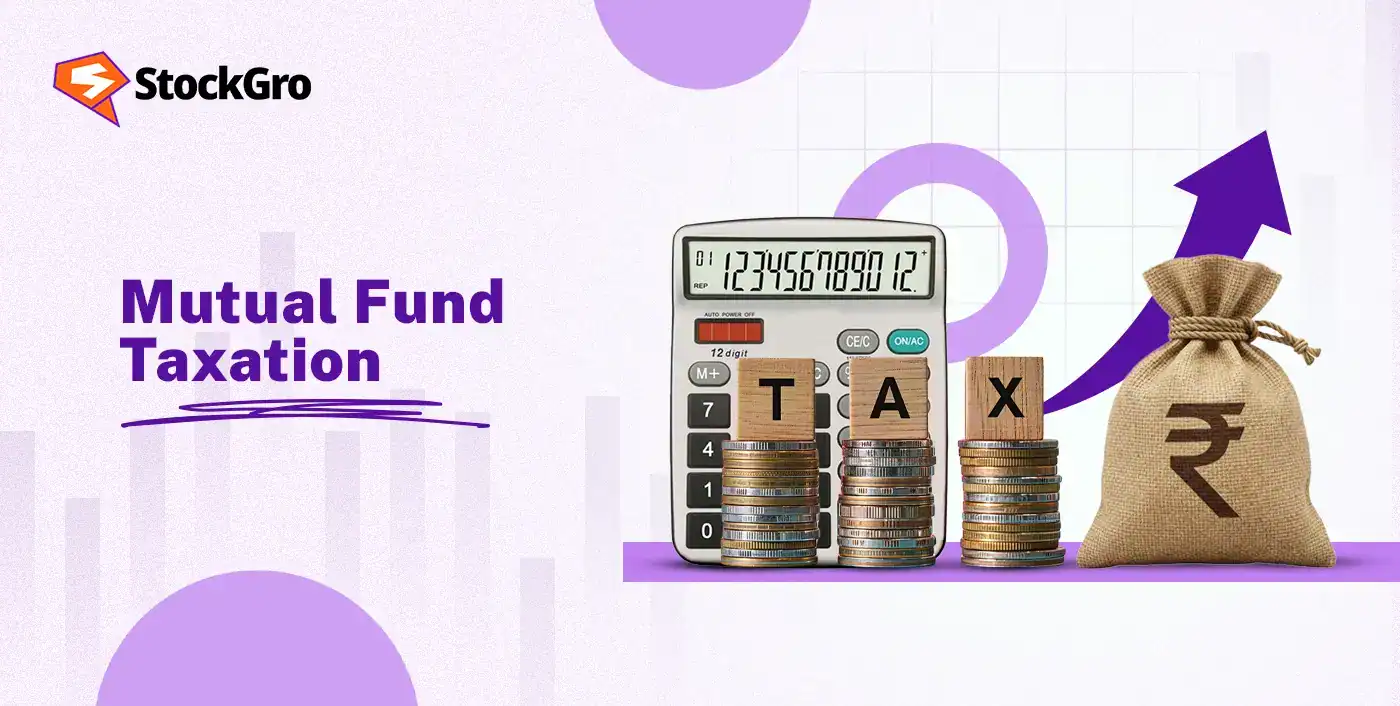
SIP inflows in mutual funds continued to climb to ₹29,361 Cr in September, from ₹26,632 Cr at the start of the financial year 2025-26. This rising SIP inflow highlights growing confidence and interest among investors in building wealth through mutual funds. But before celebrating mutual fund gains, let’s get into how they’re taxed.
Understanding mutual fund taxation is game-changing for investors, as it directly affects the overall returns they receive and take home. With different types of funds, such as equity, debt, or hybrid, taxed differently depending on the holding periods, knowing these rules helps investors to level up planning, post-tax gains, and strategies to make investment decisions that meet targets.
Mutual fund taxation
Investing in mutual funds yields returns in the form of dividends or capital gains when sold or redeemed, or both, which are subject to taxation. Taxation on mutual funds depends on the type of fund, whether it is an equity fund, a debt fund, a hybrid fund, or an SIP fund, and the holding period, which could be either short-term or long-term.
Why It Matters to You
Understanding mutual fund taxation helps investors make strategic investment plans and make the most of their post-tax returns.
- Direct hit on returns: Whether an investor sells or redeems their mutual funds, they are subject to taxation no matter what. For capital gains on redemption or sale, the tax rate depends on the type of fund and the holding, while in the case of dividends, it is taxable as per income tax.
- Drives investing and strategy: Understanding tax on mutual funds helps in building strategies and better investment planning for selecting the right funds, timing sales or redemptions, and maximizing returns.
Equity Mutual Fund Tax Rules (STCG & LTCG)
Equity mutual funds hold a minimum of 65% or more equity shares. Their capital gains taxation structure is as follows:
| Equity Mutual Fund Tax Rules | Tax Rates |
| Short-term capital gains (1-year or less) | Flat 20% tax |
| Long-term capital gains (more than 1-year) | 12.5% on capital gains above ₹1.25 lakh |
Debt & Hybrid Fund Taxation Changes
All capital gains from debt funds are taxable under the income tax rule, while hybrid fund taxation depends on its equity allocation.
| Mutual Fund Tax Rules | STCG Tax Rates | LTCG Tax Rates |
| Debt funds | Taxable as per income tax rates | Holding period does not matter here, all capital gains from debt funds are taxed as per income tax rules, effective from 1 April 2023. |
| Hybrid funds | If the fund holds over 65% equity, it is taxed as equity mutual funds.If the fund holds less than 65% equity, it is taxed as debt funds. | Same as STCG |
Dividend & ELSS Tax Treatment
For dividend income on mutual funds, it is taxable as per income tax rules, and a TDS of 10% is deducted on dividend income of more than ₹5000.
Now, let’s see how ELSS funds are treated for taxation purposes:
| Holding period | ELSS funds has a mandatory lock-in period of 3-years |
| Deduction | Up to ₹1,50,000, under Section 80C of old tax regime |
| Tax rate | For capital over ₹1.25 lakh, flat 12.5% tax is charged |
SIP Taxation & FIFO Method
SIP taxation is based on the First-in First-out ( FIFO) method. Here, the SIP instalments are considered single investments, and each of these has its own purchase date, based on which the holding period is calculated. Due to this, the FIFO method is automatically applied to avoid manual picking of units during redemption or sale.
Let’s understand with an example how it works:
An investor started a monthly SIP of ₹4,500 in the SBI Bluechip Fund in February 2024. After holding for 18 months, the investor decided to sell ₹45,000 worth of units in August 2025.
According to the FIFO method, the first 12 instalments have a holding period of over 12 months and are subject to long-term capital gains tax, and the rest are subject to short-term capital gains tax.
After that, capital gains from SIP mutual funds are taxable depending on the type of fund and holding period, similar to other mutual funds.
NRI-Specific Taxation Rules
Here’s a summary of NRI-specific taxation rules in India:
| Type of Funds | STCG Tax | LTCG Tax | TDS |
| Equity funds | 20% | 12.5% | 20% on STCG, 12.5% on LTCG |
| Debt funds | As per income tax slabs | As per income tax slabs | 30% |
| Hybrid funds | If the fund holds over 65% equity, it is taxed as equity mutual funds.If the fund holds less than 65% equity, it is taxed as debt funds. | If the fund holds over 65% equity, it is taxed as equity mutual funds.If the fund holds less than 65% equity, it is taxed as debt funds. | 30% on STCG, 20% on LTCG |
| Dividend income | As per income tax rules | As per income tax rules | 20% |
Strategies to Minimise Tax
- Invest in Equity-Linked Savings Scheme (ELSS): Investing in ELSS funds offers a three-year lock-in period and allows for a tax deduction of up to ₹1.5 lakh under Section 80C of the old tax regime.
- Tax-loss Utilisation: Investors can carry forward capital losses by selling underperforming assets to offset capital gains, which reduces the overall taxable amount.
- Strategic Redemption: Investors can utilise the annual LTCG exemption limit of ₹1.25 lakh for equity funds by planning redemptions and avoiding paying tax on a portion of gains.
Filing ITR: Reporting MF Gains
Here are the steps to follow while filing ITR and reporting capital gains on mutual funds:
| Step 1: Gather reconciled documents | Gather the Consolidated Account Statement (CAS), capital gains statements, Form 26AS, and Annual Information Statement (AIS), by reconciling with the AIS. |
| Step 2: Log-in | Log-in to the official portal of the Income Tax Department at ‘incometax.gov.in’ |
| Step 3: Select the right ITR form | Investors should select the right ITR form, depending on income source and capital gains or losses. |
| Step 4: Report capital gains | Report capital gains on the ‘Income Schedules’ section |
| Step 5: Report capital losses | Report any capital losses on the ‘Income Schedules’ section, filing before the due date allows investors to carry forward capital losses up to 8-years |
| Step 6: Report dividends | Report dividend income on the ‘Income from Other Sources’ section |
| Step 7: Review and submit | Carefully review the entered details and hit the submit button |
| Step 8: E-verify | E-verification should be completed within 30 days of filing returns |
To sum up, understanding the concept of mutual fund taxation helps investors to make strategic plans for investment and redemption. And, concepts like FIFO, STCG, LTCG, and fund-based taxation can help investors optimise their profits. With proper planning, investors can not only grow wealth but also retain more of it by being tax-savvy and making timely financial decisions.
FAQs
The short-term or long-term taxation depends on the type of mutual fund. For equity mutual funds, STCG is taxed at 20%, and LTCG is taxed at 12.5% on capital gains for ₹1.25 lakh. While for debt funds, capital gains are subject to the income tax rate, irrespective of the holding period.
SIP mutual funds are taxed using the FIFO method. In the FIFO method, each SIP instalment is regarded as an investment and has its own purchase date, based on which the holding period is calculated. In case of redemption, units held over 12 months are subject to the LTCG rate, and units held for less than 12 months are subject to the STCG tax rate.
The LTCG exemption limit on equity mutual funds in 2025 is ₹1.25 lakh, and above that, long-term capital gains are subject to a flat 12.5% tax.
Yes, dividends from mutual funds are taxable according to the income tax rates, and a 10% TDS on dividend income over ₹5,000 in a financial year is deducted.
If debt mutual funds are bought after 1 April 2023, the capital gains on these funds are taxable as per the income tax rule, with no effect from the holding period.
ELSS funds have a mandatory lock-in period of 3 years. So, all capital gains are LTCG and are subject to 12.5% tax. Besides, it offers deductions up to ₹1.5 lakh on the total taxable amount, and an exempt LTCG tax rate on gains below ₹1.25 lakh.
For NRIs, taxation on capital gains is similar to regular mutual funds. Additionally, they are also subject to TDS. For equity funds, TDS is deducted at 20% for STCG, 12.5% for LTCG. For debt funds, 30% TDS is deducted, while for hybrid funds, 30% TDS is deducted for STCG and 20% TDS is deducted for LTCG. Also, dividend incomes are subject to a 20% TDS.

